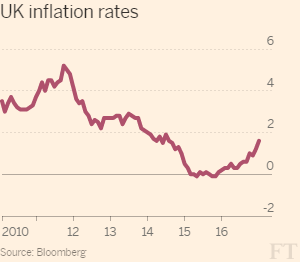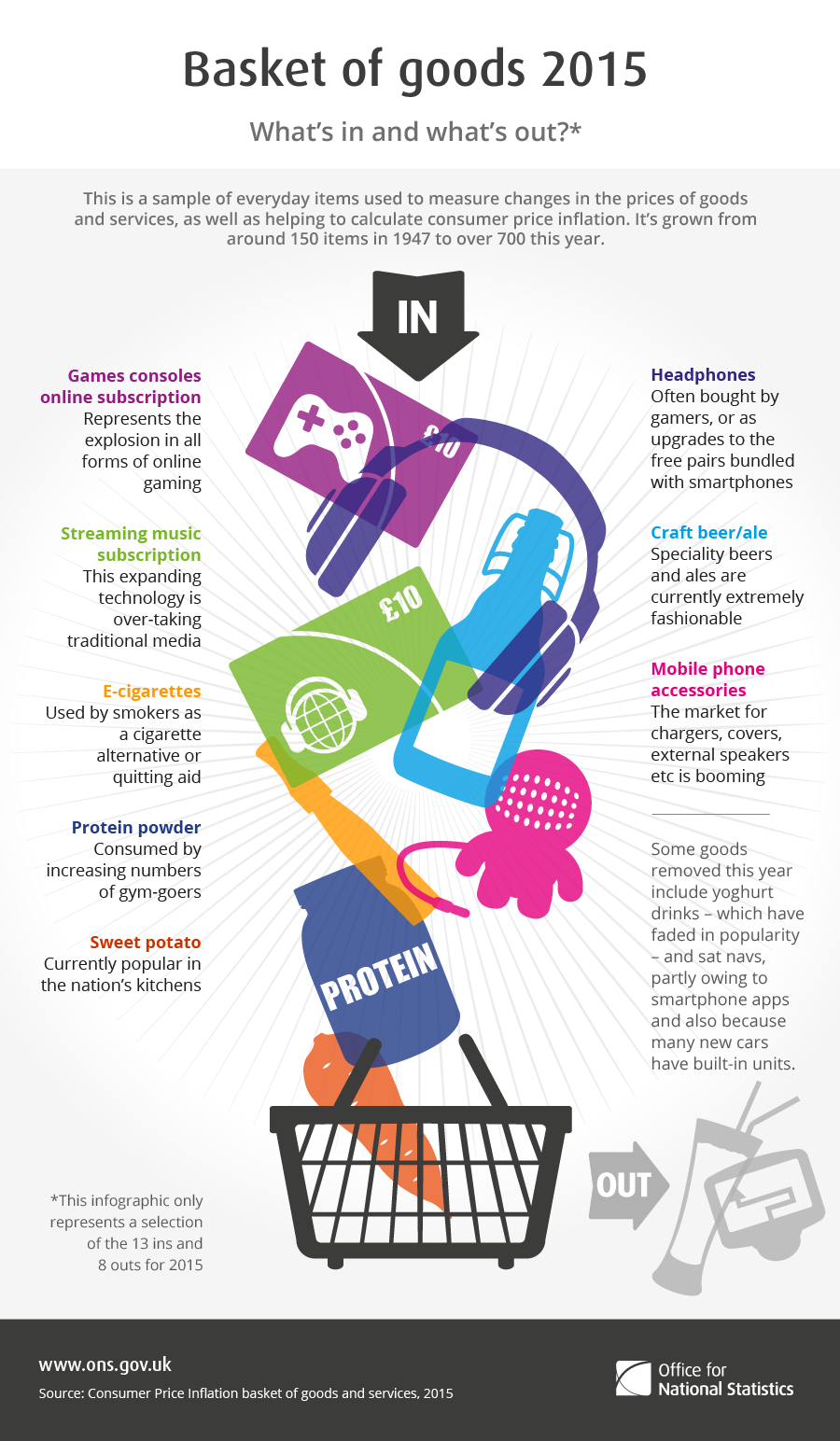
How should advisers be positioning client portfolios to protect against rising inflation ?
With the Office for National Statistics recently announcing that inflation has reached 1.8 per cent in the UK - just one percentage point away from the predicted 2.8 per cent expected in 2018, investors are right to be concerned.
True, this is nowhere near the heady days of the 1970s, when inflation was peaking in double-digits, but with every inflation hike comes a rise in prices of everything from white goods to milk.
Add to this the fact that wage inflation - a measure which the Bank of England has said it is taking into account when calculating whether to raise interest rates or not - is hardly keeping pace with the prices of goods, and it is clear savers are finding it hard for their cash to stretch.
This is why investors are starting to look beyond the perceived safety of cash and head towards other investments. The question is, which investments will be inflation proof? This report aims to provide some answers to this question.
Inflation-proofing and Isa investments: what advisers are doing
Inflation-proofing should be on the table when it comes to choosing Isa investments this season, Adrian Lowcock has suggested.
The investment director for multi-manager Architas said inflation proofing should be something advisers consider for their clients over the coming months.
He explained: "Investors haven’t had to worry about inflation for a long while. But in 2017 inflation has returned with the Bank of England forecasting inflation will reach 2 per cent in February this year and peak at 2.8 per cent by 2018."
According to Mr Lowcock, the return of inflation is widely expected by the market as the recovery in the oil price and the fall in the pound following the EU referendum are likely to drive prices higher.
While the inflation estimates are nowhere near the giddy heights of the 1970s; indeed not even as high as they were in 2011, Mr Lowcock warned that investors should consider this as a factor when they come to make their investment decisions in their stocks and shares Isas.

Inflation is ticking up in the UK
He commented: "As such traditional inflation proofing assets such as index linked gilts, have already priced in much of the anticipated rise in inflation.
"Alternative income assets, such as infrastructure, tends to respond more slowly as investors look to these sectors last."
The comments came as advisers taking part in a Talking Point poll for FTAdviser said they were also looking to diversify their clients' portfolios into inflation-hedging asset classes.
Among those surveyed, 35 per cent said they were heading to equities, with clients accepting a little more risk for the sake of potentially inflation-beating returns.
In close contention was property investment (both residential and commercial) as a means to outpace inflation.
simoney.kyriakou@ft.com
Global inflation puts advisers on alert
Tesco, Toblerone and technology: inflation has affected all of these over the past few months.
Last year, Tesco famously announced it would fight off the worst of any Brexit-induced price inflation, after a major supplier - Unilever - said it would have to put up the price of certain goods, including that much-loved and yet much-hated food cupboard stalwart, Marmite.
Following swiftly on from Marmitegate came Tobleronegate: the price of raw cocoa rising so much that the nation's adored Alpinesque chocolate treat was reduced to an edible toast rack.
Economists have pinned this price rise on the drops in sterling as a result of the UK's vote to leave the European Union, and according to some, this inflation should not necessarily be seen as a sign of a failing economy.
Guy Stephens, technical investment director at Rowan Dartington, comments: "While we expect inflation to rise as the effects of sterling's fall are reflected in import cost rises, this is not bad inflation as caused by rampant wage growth and an overheating economy. Excessive demand is not a problem."
Yet it is affecting some households and savers. While the price-lifting and value-eroding power of inflation - a double-edged economic sword - can be seen in the goods people buy and consume, it is often less visible in long-term savings.
Figure 1: What's in the consumer price index?

Cash
Investors and savers wanting a measure of security and certainty have, in times of economic turmoil, turned to the relative safety of cash: deposits, savings accounts, cash Isas, National Savings & Investments' premium bonds and even money market funds.
Yet while there is a high level of assurance in cash, with protection under the Financial Services Compensation Scheme of the first £85,000 of cash savings, the interest rates available to investors is risible.
Since the Bank of England's financial policy committee reduced the rates from 0.5 per cent to 0.25 per cent on 11 August 2016, high street banks and building societies have been reducing their own rates on savings and e-savings accounts.
For example, Santander's basic savings account stands at a mighty 0.01 per cent interest rate.
Last year, the FCA published data showing the lowest interest rates offered by 32 providers of easy access cash savings accounts and easy access cash Isas.
The data formed part of the FCA’s so-called ‘sunlight remedy’, which aims to shine a light on firms’ strategies towards their long-standing customers.
Given that inflation estimates from the Bank of England have suggested inflation could creep up to 2.8 per cent over the next 12 months, perhaps even peaking at 3 per cent by the end of 2018, this should raise the alarm for your cash investors.
Find me a cash Isa with relatively good ease of access and not requiring a high minimum investment, which pays me more than the estimated 2.8 per cent inflation, and I'll send you a free copy of whichever book happens to be on my desk at the time.
Add to this the Bank of England has already predicted the average wage increase is set to fall this year, from near 3 per cent in 2015 on average to approximately 2 per cent in 2017.
The latest salary data from consultancy Mercer states:
- 2017 base salary increases for all roles are expected to be between 1.9% and 2.4%.
- The majority of organisations predict 2017 annual incentive levels to remain similar or unchanged to 2016.
- It is clear not only cash savings but also wages are unlikely to beat inflation.
So if cash can't help your clients, what can?
Bonds
Seen as lower risk than equities, bonds have traditionally been a good port of call for investors seeking a higher-than-inflation return on their investment portfolios.
The current yield on a 10-year UK government bond (gilt) is 1.27 per cent, according to Bloomberg's daily prices (as at 10 February 2017). This is down 14 percentage points year on year and way below inflation estimates.
While this is not as attractive as the current yield on a 10-year US treasury (T-Bill) of 2.4 per cent, and certainly better looking than the 10-year yield of 0 per cent on a Japanese government bond, there are serious macroeconomic risks involved, such as interest rate risk, that could affect the yield.
Moreover, as we have seen in recent months, things can change so quickly investors should beware of a long duration on their bond holdings.
Short-duration strategies are one way that some fund managers and advisers are mitigating the ravages of inflation and the potential interest rate risk on their client's portfolios.
Last year, Fidelity International launched a Short Dated Corporate Bond fund, managed by Ian Spreadbury and Sajiv Vaid, to keep up with investor demand for a fund that delivers capital growth in a low risk manner.
Mr Spreadbury said: “Short dated credit is an ideal solution for investors who desire a modestly higher yield and risk profile than cash and government bonds, but who consider a conventional corporate bond fund a step too far.
“Short dated corporate bonds exhibit lower drawdown and volatility than their all-maturity counterparts, and their short nature ensures that bonds will be naturally maturing while in the portfolio, providing sufficient liquidity.”
Index-linked securities are one way of hedging against inflation, but as Adrian Hull, senior fixed income product specialist at Kames Capital told FTAdviser, while this can help with inflation proofing, there are, like short-duration bonds, downsides.
He explains: "Neither asset class is cheap as investors have already future proofed portfolios for such outcomes.
"Despite this rational response it is likely that headline UK RPI will push higher than the whole of the nominal gilt yield curve in 2017 – repeating valuations of 2011.
"Therefore, index-linked securities are likely to be better performers if inflation is higher than the current consensus of RPI at around 2.75 per cent in 2017."
Equities
1) Domestic
UK equities could be a way for investors to diversify away from low-growth assets such as cash and bonds and achieve potentially higher-than-inflation returns - but of course there is higher commensurate risk involved.
The FTSE 100 index rose 28.03 per cent year on year; an index-tracking fund would have far outstripped inflation over the same period.
That said, political uncertainty over the nature of Brexit - hard, soft, middling - as well as any effects from the policies implemented by our special relationship partner the US - could see further volatility on the downside.
Regardless, it's hard to envisage inflation ticking up to high double-digits, although history of economics suggests nothing is impossible.
For now, inflation even at a 2.7 or 2.8 per cent peak, will still be at a much lower level than it was in 2011-2012 (see Figure 2: UK inflation. Source: Bloomberg/FT).
2) Europe
Dylan Ball, executive vice president, Templeton Global Equity Group, is anticipating 2 per cent inflation in the eurozone, but believes this might be useful to help European equities.
He believes the prospect of higher inflation across the eurozone could be the catalyst that helps close the earnings gap.
Mr Bell says: "After a year in which political surprises dominated headlines across the globe, we believe conditions are lining up for a positive year for European equities—and not before time.
"As value investors, we try to stay focused on a longer-term investment horizon and use volatility as an opportunity to look for undervalued companies.
"More important for the asset class in 2017, we believe, is the prospect of higher inflation, which now seems likely to be coming down the pike. Inflation, in our view, should be positive for European earnings."
He explains that, traditionally, inflation has tended to lag movements in energy and commodity prices by approximately three to four months.
By September last year, the price of oil had recovered from its historic lows, moving back up to around US$50 a barrel.
If advisers were worried about inflation ravages, then index-linked securities and gold are the usual protection
The effect of that price increase is now showing up in the inflation figures, suggesting to the Franklin Templeton team that Europe could be moving from a 1 per cent to 2 per cent inflation environment; perhaps even as high as 3 per cent to 4 per cent.
3) Asia and emerging market equities
The strong run of flows into emerging market (EM) equity funds came to an abrupt halt in November, with Trump's election, data from Cerulli Associates has stated.
Despite the slowdown in investments into emerging market equity funds at the tail end of last year, partly because of worries about a stronger dollar, higher interest rates, and protectionist policies, overall, fund flows were positive for 2016. Cerulli believes 2017 will see the EM flow recovery resuming.
However, while strong inflation fears persist in the major Western economies, inflation has been operating very differently in Asian and emerging market economies and investors seeking to pile into these markets should pay close attention to how inflation affects various economies.
For example, in August last year, the Bank of Japan was explicit about its desire to raise inflation and boost its economy, as retailers warned of consumer prices sliding for the fifth consecutive month. A little more inflation would be a welcome sign for Japanese equities.
Meanwhile, in China, rising inflation is not so welcome. Last year, consumer prices in China rose 2.1 per cent year on year (at the end of October 2016) and market expectations are that inflation could stand at 3 per cent by the end of the year.
4) US
Keith Wade, chief economist for Schroders, is sceptical about the growth plans being put in place by US President Donald Trump.
He believes the new administration might be effective at hiking inflation rather than job creation and fiscal stimulus.
Mr Wade explains: "We remain sceptical on the ability of the new administration to generate a sustained upturn in growth and employment through fiscal policy and trade protection.
"This reflects the time likely to be taken to get a fiscal package through Congress and the actual growth impact of tax cuts aimed at corporations and the wealthy. More fundamentally, we also believe that the US is late cycle with the labour market close to full employment, so stimulus is likely to deliver more in the way of inflation than jobs.
"Meanwhile trade protection effectively limits the available supply of goods to a market, thus increasing upward price pressure. The same can be said of measures to prevent companies from trying to reduce costs by relocating abroad. Inflation remains the most likely outcome of the new president’s economic policies."
According to Rowan Dartington's Mr Stephens, advisers might be best placed to consider alternative ways of inflation-proofing a portfolio.
He comments: "If advisers were worried about inflation ravages, then index-linked securities and gold are the usual protection, as well as real assets connected to that source of inflation - so property, commodities and equities."
We also believe that the US is late cycle with the labour market close to full employment, so stimulus is likely to deliver more in the way of inflation than jobs
For example, gold has had a volatile year, but according to the Comex Gold 1 Futures chain, the price is up 2.22 per cent year on year, and currently trading at $1,224.3 per troy ounce (as at 10 February, according to FT.com).
While UK residential property prices have come under pressure, latest data from the Halifax House Price Index shows house prices at the end of January 2017 were 5.7 per cent higher than in January 2016.
Likewise, despite 2016's property fund gate-gate last year, when several open-ended commercial property funds had to shut their doors to transactions temporarily over Brexit fears, commercial property funds, on average, rose an average of 9.3 per cent over the year to 27 January (calculated bid-to-bid, net income reinvested, based on FE Trustnet data).
Cash is no longer a risk-free return but more like a return-free risk
Gravis Capital Partners' Stephen West, partner and adviser to the VT UK Infrastructure Income fund (UKIIF) says: "Inflation protection can be added to clients’ portfolios by investing in long term cash flows that have upward only inflation links."
For example the UKIIF Fund offers exposure to the long term cash flows generated by infrastructure assets that are core to the economy, almost all of which are fixed rate and benefit from upward only adjustments as inflation rises.
He states: "This contrasts with bond funds where given the close correlation of inflation and market interest rates, and the fixed duration (which infrastructure cash flows do not exhibit), values fall as inflation rises (the exception being inflation linked bonds, where prices gain, but with the disadvantage of extremely low yields, generally well below infrastructure asset levels).
"The popularity of fundraising by closed-ended renewables infrastructure and traditional infrastructure funds, in which UKIIF is an active participant, highlights the trend of investors seeking consistent, dependable income with inflation linkage and finding it beyond the traditional asset classes."
Diversification remains key. Earlier in February, Newcastle-headquartered advisory firm True Potential carried out research into the performance of cash Isas compared with a stocks and shares Isa, which was invested into a multi-asset portfolio.
Its analysis suggested that, even after deducting platform (0.4 per cent) and average fund (0.83 per cent) charges, the Balanced True Potential Portfolio grew by 12 per cent.
Isa investors in that portfolio saw an overall growth of £3.8m. Extrapolating that, the data suggests that savers who place their full £20,000 2017/18 Isa allowance on April 6 into cash may receive around £200 in interest, while a stocks and shares Isa could return around £2,400.
Mark Henderson, senior partner at True Potential, comments: “There is still widespread inertia that means many savers remain overly exposed to cash. Everyone needs a rainy day fund but inflation is higher than most cash Isa rates.
"By being overly-conservative, these savings are missing an opportunity to grow and, worse, they are losing value. Cash is no longer a risk-free return but more like a return-free risk."
simoney.kyriakou@ft.com


